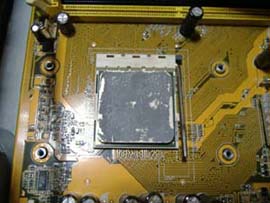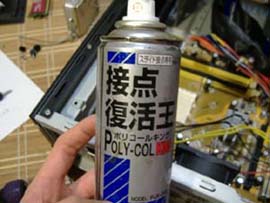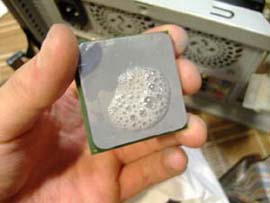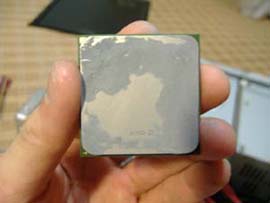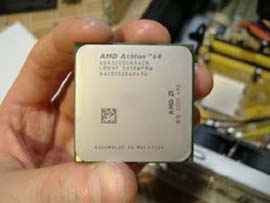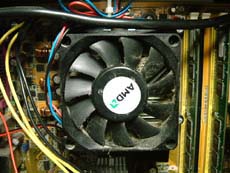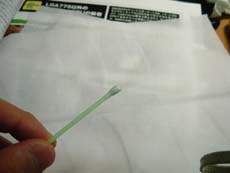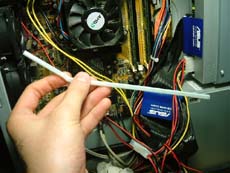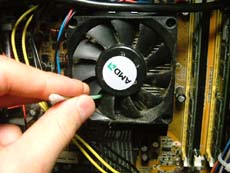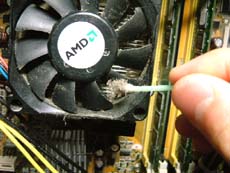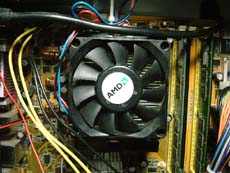これまでCPUはAMD Athlon64 3200+(2.0GHz)を使ってきたのですが、
さすがにシングルコア(コア1つ)だと役不足になってきたので、
同じく上位機種であるAMD Atlon64 X2 5200+(2.6GHz) の
デュアルコア(コア2つ)にCPUを交換したいと思います!
動作クロックだけ見ると2.0→2.6ですが、
コアの数が1つ→2つになるというのは処理速度がかなり違ってきますので、
これは期待がもてそうです(^^)
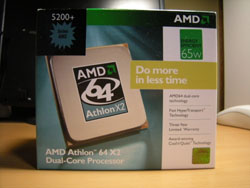
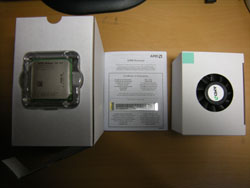
AMD Atlon64 X2 5200+をさっそく購入しました!
現在、発売からかなり時間がたっており値段もかなり下がっていましたので、
東京の秋葉原を歩いて一番安いお店で10000円ジャストで購入!
これはかなりいい買い物をしたんではないでしょうかヾ(=^▽^=)ノ
価格.comよりも安かったです!
CPUのバルクはこわいんで、ちゃんとしたパッケージ品を購入。
中にはCPU本体、CPUクーラー、説明書が同封されています(右写真)
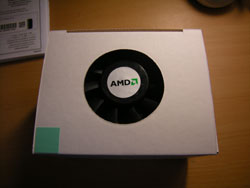
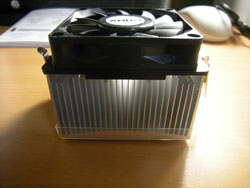
CPUクーラーです。パッケージ品なのできちんと付属しています。
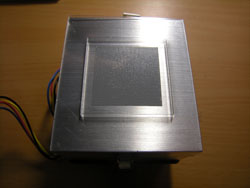
CPUクーラーの裏面のCPUと密着する部分です。
カバーがかかっていますが、グリスが薄く塗られています。
グリスはこれくらい薄くてOKということがわかりますね。
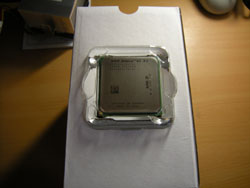
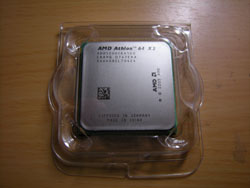
CPUはこんな感じです。
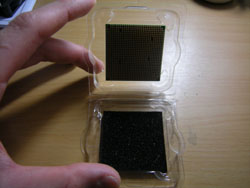
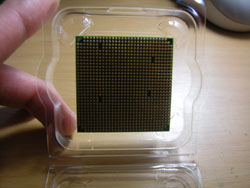
カバーの中をあけるとスポンジでピンの部分がガードされています。
ピンに曲がりや欠けなどないか確認しておきましょう! (右写真)
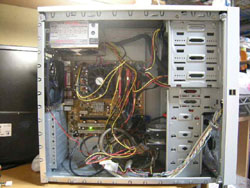
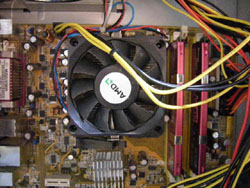
まずはCPUファンを取り外していきます!
参照先→冷却装置(CPUファン)の取り外し方法
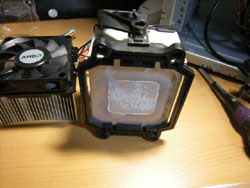
こんな風に黒いマウントごとはずれましたね。
このマウントも新しいCPUクーラーに流用するので取り外します。
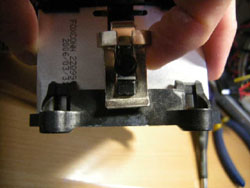
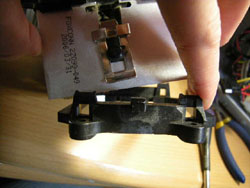
ひっかかっているツメをはずすだけです。
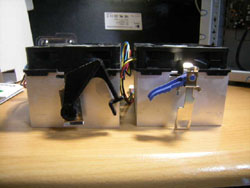
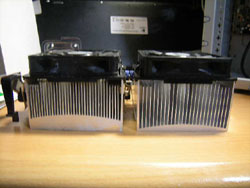
古いCPUクーラーと、新しいCPUクーラーを観察してみます(^^)
左が古いCPUクーラー、右が新しいCPUクーラーです。
(左写真)固定レバーは新しい方がカンタンなつくりになっていますね。
(右写真)クーラーの隙間は新しい方が大きくなり、高さも広くなっています。
これは冷却効果が期待できそうですね(^。^)
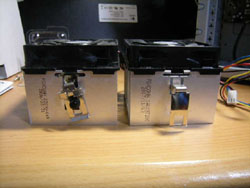
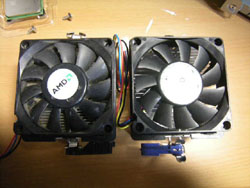
(左写真)左の古いCPUクーラーは中心が固定レバーの棒を通すために
空洞になっているのですが、右の新しいCPUクーラーにはそれがありませんね。
やはり構造の簡素化が図られているようです。
(右写真)冷却ファンは特に大きな変化はないようです。
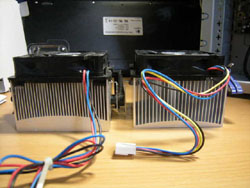
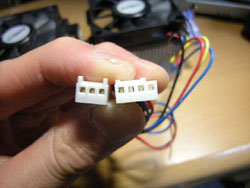
電源コードをみていきますが、
左の古いケーブルが3ピンに対し、
右の新しいケーブルは4ピンに増えていますね(右写真)
4ピンになることで、PWM機能というものが使えるようになります。
この機能は マザーボードの環境センサなどで必要なファンの回転数を計算し、
CPUファンの回転数を自動的に適切な回転数にしてくれます。
またPWM機能は純正のCPU、CPUクーラー、CPUファンの組み合わせでのみ機能します。
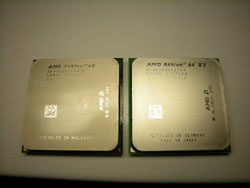
CPUの表面です。
CPU名がAMD Athlon64からAtlon64 X2になっています。
それ以外は特に変化なしです。
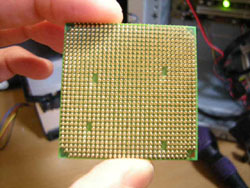
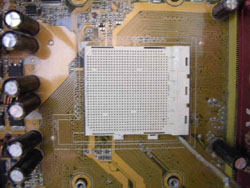
新しいCPUを取り付けていきます!
CPUの裏面のピンのないところと
マザーボード側のソケットの切り欠きをあわせて取り付けていきます!
CPU表面の角にかいてある△印と
マザーボード側のソケット角にかいてある△印をあわせてもいいです。
ここはけっしてずれたり、浮いたりしないように注意してしっかりと取り付けましょう!
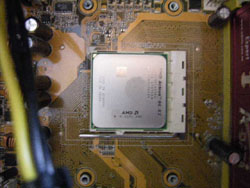
きちんとロックレバーも下ろしておきましょう!
しっかりカチッとなるまでしっかりと下ろしきります。
(力をいれすぎて曲げないように注意)
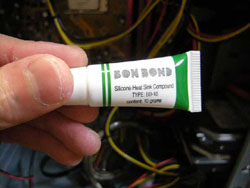
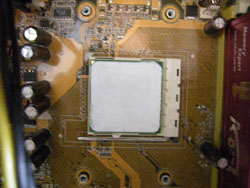
CPUの表面には専用のグリスを塗ります。
これがないと放熱がうまくできなくなります。
うす~く均一に塗るように心がけましょう!
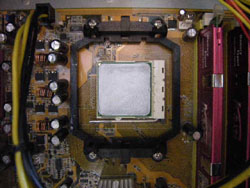
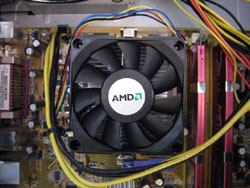
後はマウントを取り付けて(左写真)
CPUクーラーも(右写真)のようにねじをしめて、
固定レバーをおろして元通りにするだけです!
ここでハードの取り付けはひととおり終わりましたね!(^^)
では、コンピューターを起動してみましょう!
起動できましたか?不具合はないですか?
スタートメニュー→マイコンピュータを右クリック→プロパティ
でCPUの状態を確認してみましょう↓
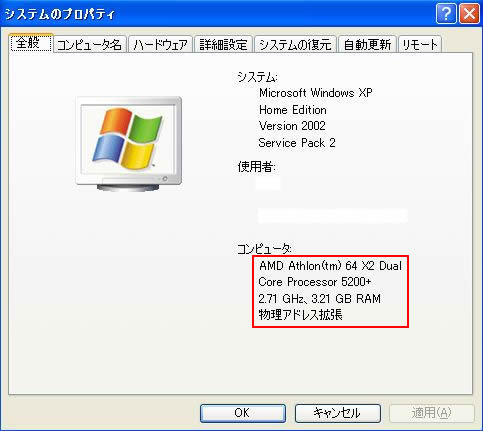 図
図
きちんと認識していますね。
これでハードの取り付けは完了です!
下の<注意事項>をお読みください。
おつかれさまでした~m(_ _)m
<注意事項>
今回はシングルコアからデュアルコアに交換しましたが、
コアが1つ→2つになりました。
こういった場合、OS側がシングルコアに対応しているので、
デュアルコアにした場合、
急に電源が落ちる、フリーズするといった不具合がでることがあります。
実はOSというのは、外から見ていると何も変わらないように見えますが、
インストール時に構成ハードウェア情報を収集し、
内部設定と初期ドライバを構築します。
また、それらの情報は一部レジストリにも反映されます。
ですので、コアの数が変わる場合は
OSは新たにクリーンインストールをするようにします。
こうすることでOSが自動的にデュアルコアに対応してくれるので、
デュアルコアCPUの性能をフルに発揮してくれます!
コアの数が同じであっても少なからずゴミ情報が残存するので、
できればOSのクリーンインストールをおすすめします!
また私の場合、
マザーボードのBIOSバージョンが少し古く、
新しいCPUに対応していなかったので、
BIOSのアップデートをする必要がありました。
BIOSのアップデートをしないと、パソコンが起動しないという不具合がでた為です。
この場合、交換前のCPUでBIOSのバージョンをアップデートし、
最新のものにしてから新しいCPUに交換することで、きちんと動作するようになります。
BIOSのアップデート方法はこちら→BIOSのアップデート方法
ですので、一世代前のマザーボードを流用する方は、
マザーボードメーカーのHPでお持ちのマザーボードのBIOSバージョンが
目的のCPUに対応しているかどうか確認してみましょう!
さすがにシングルコア(コア1つ)だと役不足になってきたので、
同じく上位機種であるAMD Atlon64 X2 5200+(2.6GHz) の
デュアルコア(コア2つ)にCPUを交換したいと思います!
動作クロックだけ見ると2.0→2.6ですが、
コアの数が1つ→2つになるというのは処理速度がかなり違ってきますので、
これは期待がもてそうです(^^)


AMD Atlon64 X2 5200+をさっそく購入しました!
現在、発売からかなり時間がたっており値段もかなり下がっていましたので、
東京の秋葉原を歩いて一番安いお店で10000円ジャストで購入!
これはかなりいい買い物をしたんではないでしょうかヾ(=^▽^=)ノ
価格.comよりも安かったです!
CPUのバルクはこわいんで、ちゃんとしたパッケージ品を購入。
中にはCPU本体、CPUクーラー、説明書が同封されています(右写真)


CPUクーラーです。パッケージ品なのできちんと付属しています。

CPUクーラーの裏面のCPUと密着する部分です。
カバーがかかっていますが、グリスが薄く塗られています。
グリスはこれくらい薄くてOKということがわかりますね。


CPUはこんな感じです。


カバーの中をあけるとスポンジでピンの部分がガードされています。
ピンに曲がりや欠けなどないか確認しておきましょう! (右写真)


まずはCPUファンを取り外していきます!
参照先→冷却装置(CPUファン)の取り外し方法

こんな風に黒いマウントごとはずれましたね。
このマウントも新しいCPUクーラーに流用するので取り外します。


ひっかかっているツメをはずすだけです。


古いCPUクーラーと、新しいCPUクーラーを観察してみます(^^)
左が古いCPUクーラー、右が新しいCPUクーラーです。
(左写真)固定レバーは新しい方がカンタンなつくりになっていますね。
(右写真)クーラーの隙間は新しい方が大きくなり、高さも広くなっています。
これは冷却効果が期待できそうですね(^。^)


(左写真)左の古いCPUクーラーは中心が固定レバーの棒を通すために
空洞になっているのですが、右の新しいCPUクーラーにはそれがありませんね。
やはり構造の簡素化が図られているようです。
(右写真)冷却ファンは特に大きな変化はないようです。


電源コードをみていきますが、
左の古いケーブルが3ピンに対し、
右の新しいケーブルは4ピンに増えていますね(右写真)
4ピンになることで、PWM機能というものが使えるようになります。
この機能は マザーボードの環境センサなどで必要なファンの回転数を計算し、
CPUファンの回転数を自動的に適切な回転数にしてくれます。
またPWM機能は純正のCPU、CPUクーラー、CPUファンの組み合わせでのみ機能します。

CPUの表面です。
CPU名がAMD Athlon64からAtlon64 X2になっています。
それ以外は特に変化なしです。


新しいCPUを取り付けていきます!
CPUの裏面のピンのないところと
マザーボード側のソケットの切り欠きをあわせて取り付けていきます!
CPU表面の角にかいてある△印と
マザーボード側のソケット角にかいてある△印をあわせてもいいです。
ここはけっしてずれたり、浮いたりしないように注意してしっかりと取り付けましょう!

きちんとロックレバーも下ろしておきましょう!
しっかりカチッとなるまでしっかりと下ろしきります。
(力をいれすぎて曲げないように注意)


CPUの表面には専用のグリスを塗ります。
これがないと放熱がうまくできなくなります。
うす~く均一に塗るように心がけましょう!


後はマウントを取り付けて(左写真)
CPUクーラーも(右写真)のようにねじをしめて、
固定レバーをおろして元通りにするだけです!
ここでハードの取り付けはひととおり終わりましたね!(^^)
では、コンピューターを起動してみましょう!
起動できましたか?不具合はないですか?
スタートメニュー→マイコンピュータを右クリック→プロパティ
でCPUの状態を確認してみましょう↓
 図
図きちんと認識していますね。
これでハードの取り付けは完了です!
下の<注意事項>をお読みください。
おつかれさまでした~m(_ _)m
<注意事項>
今回はシングルコアからデュアルコアに交換しましたが、
コアが1つ→2つになりました。
こういった場合、OS側がシングルコアに対応しているので、
デュアルコアにした場合、
急に電源が落ちる、フリーズするといった不具合がでることがあります。
実はOSというのは、外から見ていると何も変わらないように見えますが、
インストール時に構成ハードウェア情報を収集し、
内部設定と初期ドライバを構築します。
また、それらの情報は一部レジストリにも反映されます。
ですので、コアの数が変わる場合は
OSは新たにクリーンインストールをするようにします。
こうすることでOSが自動的にデュアルコアに対応してくれるので、
デュアルコアCPUの性能をフルに発揮してくれます!
コアの数が同じであっても少なからずゴミ情報が残存するので、
できればOSのクリーンインストールをおすすめします!
また私の場合、
マザーボードのBIOSバージョンが少し古く、
新しいCPUに対応していなかったので、
BIOSのアップデートをする必要がありました。
BIOSのアップデートをしないと、パソコンが起動しないという不具合がでた為です。
この場合、交換前のCPUでBIOSのバージョンをアップデートし、
最新のものにしてから新しいCPUに交換することで、きちんと動作するようになります。
BIOSのアップデート方法はこちら→BIOSのアップデート方法
ですので、一世代前のマザーボードを流用する方は、
マザーボードメーカーのHPでお持ちのマザーボードのBIOSバージョンが
目的のCPUに対応しているかどうか確認してみましょう!
